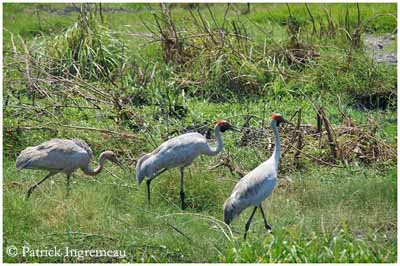
Brolga
Antigone rubiconda
Gruiforme Order – Gruidae Family
BIOMETRICS:
Length : 95-125 cm
Wingspan : 170-240 cm
Weight : 6-7 kg
LONGEVITY : Up to 33 years
DESCRIPTION:
The Brolga is a tall grey crane.
Adult has pale grey plumage overall, with wings and tail slightly darker.
Head has grey forehead and crown. Nape, auricular area, cheeks and chin are featherless and red. We can see small pale grey ear-cover spot. It also has black dewlap under the chin.
Long, pointed, straight bill is horn-coloured. Eyes are yellow, with greyish eye-ring. Legs and feet are dark grey to blackish.
Both sexes are similar in plumage, but female is smaller than male.
Juvenile is brownish-grey and darker than adults. Head is pale buff, and lacks the red bare skin.
PROTECTION / THREATS / STATUS:
Populations of south-eastern parts of the range have declined, due to drainage of wetlands for agriculture. However, the Brolga is still common and widespread in Northern Australia.
The Brolga is preyed upon by introduced Red Foxes, and can suffer collisions with power lines and others.
Fr: Grue brolga
All : Brolgakranich
Esp : Grulla Brolga
Ital : Gru Brolga
Nd : Australische Kraanvogel
Russe : Журавль австралийский
Photographs by Patrick Ingremeau
His website: TAMANDUA
Text by Nicole Bouglouan
Sources:
HANDBOOK OF THE BIRDS OF THE WORLD Volume 3 by Josep del Hoyo-Andrew Elliott-Jordi Sargatal - Lynx Edicions - ISBN : 8487334202
Wikipedia (Wikipedia, The Free Encyclopedia)
International Crane Foundation

We can find another crane species in Australia, the Sarus Crane, which has pink legs and more extended bare red skin patch on the head and upper neck.
VOICE: SOUNDS BY XENO-CANTO
The Brolga utters far-carrying trumpeting “garooo”, or longer “kaweee-kreee-kurr-kurr-kurr-kurr” uttered when flying, resting or while performing courtship displays.
HABITAT:
The Brolga lives in wetlands, wet meadows and shallow open marshes, coastal mudflats and occasionally estuaries.
It avoids arid and semi-arid areas, but it may occur near water.

RANGE:
The Brolga is abundant in north and north-east Australia, from north-east Queensland to Victoria.
It is also found in southern New Guinea and it can be seen in northern parts of Western Australia and in New Zealand.
BEHAVIOUR:
The Brolga is omnivorous and feeds in wetlands, eating plants, sedge tubers, invertebrates, small vertebrates, molluscs and crustaceans. When eating sedge tubers, the Brolga digs holes in order to extract tubers from the mud with the long bill.

The Brolgas are gregarious, often seen in pairs or family groups of 3 to 4 birds. After breeding season, they gather into large flocks where families remain separated. They do not migrate, but they can perform seasonal movements, according to rainfalls.

The Brolgas perform elaborated displays such as mating dances, as in breeding season or at any time in the year.
Dance starts by bowing and stretching, the birds walk, moving forwards and backwards while they bob the head and flap their wings, and calling. Mates can dance together or in groups of about 10 to 12 birds.
Another display shows the bird picking up some twigs, or grass or other plant material, and tossing it into the air and then, seizing it with the bill. They also jump and land by gliding. These displays are performed by both sexes and strengthen the pair bonds. Pairs are monogamous and mate for life. The Brolga may dance for its or her mate, or pairs dance together.
Parts of these dances have been included into ritual dances of Aboriginal people.

Both adults defend strongly territory and nest-site. The Brolgas are aggressive and can fight, leaping up into the air for racking intruders with their claws, or stabbing at opponent with the bill. If they are threatened at nest with chicks, parents perform broken-wing display while chicks hide.
FLIGHT:
The Brolga perform powerful flight, thanks to its large wingspan, giving several flaps before to glide. They can fly at high altitude.
REPRODUCTION:
Breeding season occurs according to rainfalls, but mainly from September to December in the south and between February and May in the north.
Nest-site of the Brolga is within an isolated territory. Nest is situated on small island in shallow water, or in marsh. It is a large mound of vegetation, a large platform made with grasses, reeds and sedges.
Female lays two whitish eggs, finely spotted with brown and purple. Incubation lasts about one month, shared by both adults. Young are fed and cared by both parents. Chicks are able to leave the nest very soon, from some hours to two days of age. At hatching, they are covered with grey down, but feathers grow within one month, and they get the entire plumage after three months. They can fly two weeks later.
The Brolga is slow-breeding bird, and usually produces one brood in two years.

DIET:
The Brolga feeds mainly on sedge tubers and crops, but also invertebrates such as insects, molluscs and crustaceans, and small vertebrates such as frogs, and occasionally mice.
